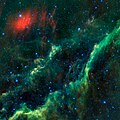Plik:Menkhib and the California Nebula.jpg

Rozmiar podglądu – 600 × 600 pikseli. Inne rozdzielczości: 240 × 240 pikseli | 480 × 480 pikseli | 768 × 768 pikseli | 1024 × 1024 pikseli | 2048 × 2048 pikseli | 4095 × 4095 pikseli.
Rozmiar pierwotny (4095 × 4095 pikseli, rozmiar pliku: 1,88 MB, typ MIME: image/jpeg)
Historia pliku
Kliknij na datę/czas, aby zobaczyć, jak plik wyglądał w tym czasie.
| Data i czas | Miniatura | Wymiary | Użytkownik | Opis | |
|---|---|---|---|---|---|
| aktualny | 15:30, 12 maj 2010 |  | 4095 × 4095 (1,88 MB) | Originalwana | {{Information |Description={{en|1=This infra-red image from NASA’s WISE (Wide-field Infrared Survey Explorer) features one of the bright stars in the constellation Perseus, named Menkhib (th |
Lokalne wykorzystanie pliku
Poniższa strona korzysta z tego pliku:
Globalne wykorzystanie pliku
Ten plik jest wykorzystywany także w innych projektach wiki:
- Wykorzystanie na ar.wikipedia.org
- Wykorzystanie na en.wikipedia.org
- Wykorzystanie na fa.wikipedia.org
- Wykorzystanie na fr.wikipedia.org
- Wykorzystanie na gl.wikipedia.org
- Wykorzystanie na lb.wikipedia.org
- Wykorzystanie na mk.wikipedia.org
- Wykorzystanie na my.wikipedia.org
- Wykorzystanie na pt.wikipedia.org
- Wykorzystanie na ro.wikipedia.org
- Wykorzystanie na ta.wikisource.org


